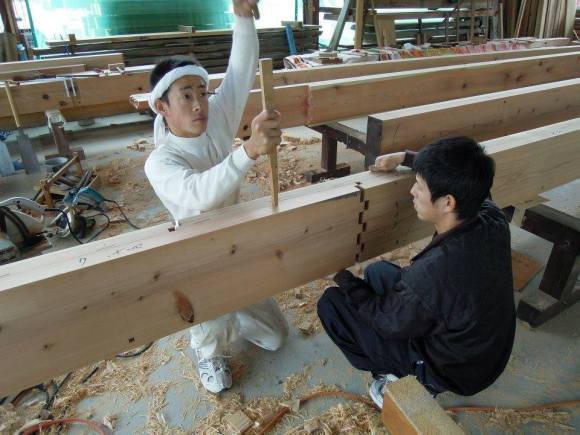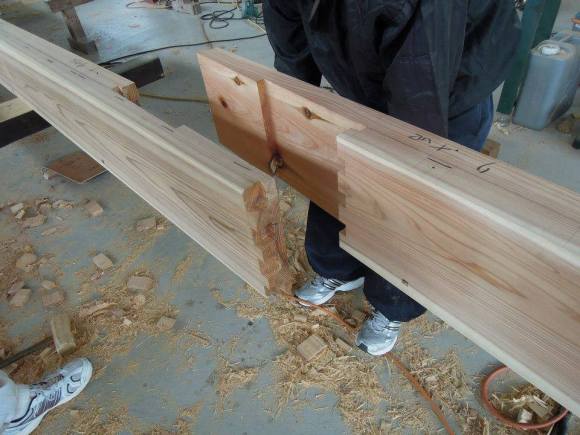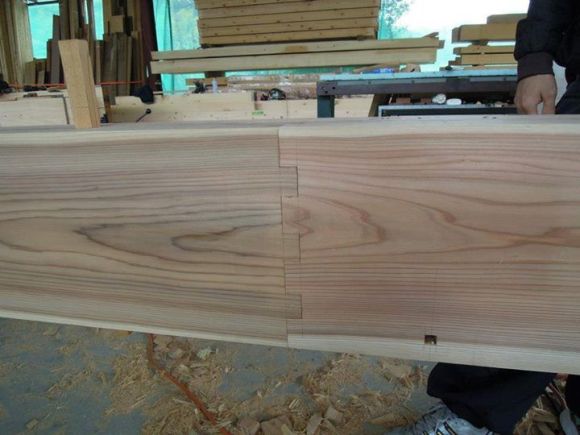
Despite Japan’s modern image as a country obsessed with the latest technologic advances and all things robotic, age-old Japanese methods and traditions are still highly valued, such as carpenters who use traditional joint-making techniques to fasten together pieces of wood without nails or screws. A video demonstrating this unique part of traditional Japanese carpentry has been making the rounds on the Internet lately with netizens amazed, and oddly mesmerized, by the almost hypnotic way these carpenters perfectly connect enormous pieces of wood.
Kobayashi Kenkoku is an architectural firm based in Ehime Prefecture which specializes in traditional Japanese carpentry. The tradesman pride themselves on keeping the ancient techniques alive, and have a YouTube channel dedicated to showcasing these unique carpentry methods.
A major feature of Japanese woodwork is how carpenters work without screws, nails, or any other metal fasteners to keep the wood together, which they say makes the foundation much stronger and longer-lasting. So to join pieces of wood together, the carpenters must make a series of complex joints that perfectly fit into one another. Here, the carpenters complete a kanawatsugi joint.
▼Two pieces of wood ready to be joined together with the magic of Japanese carpentry

The carpenters don’t use glue or any other chemical to keep the wood together, either. Instead, they slowly hammer a small piece of wood, called a plug, in between the planks to force a very tight fit that makes the two pieces of wood practically become one solid beam.
▼Slowly forcing the two pieces of wood together

▼The finished product: one single and very sturdy beam

And because there are no metal fasteners or glue, the planks can be disconnected by using the plug again to force the joint apart without damaging the wood. Take a look at the carpenters demonstrating this joint technique in the video below and let us know what you think!
Video: YouTube (小林建工)
OK, we need to watch that again right away…
Source: Curazy

 Animated GIFs of traditional Japanese woodworking joints are mesmerising to watch
Animated GIFs of traditional Japanese woodworking joints are mesmerising to watch Grimer ASMR video on official Japanese Pokémon YouTube channel is… oddly satisfying【Video】
Grimer ASMR video on official Japanese Pokémon YouTube channel is… oddly satisfying【Video】 Video of each Japanese hiragana getting “measured up” is oddly cute and satisfying【Video】
Video of each Japanese hiragana getting “measured up” is oddly cute and satisfying【Video】 Japanese rokushigake temple architecture for your living room: The no-nail Masugumi table
Japanese rokushigake temple architecture for your living room: The no-nail Masugumi table Nightingale floors: The samurai intruder alarm system Japan’s had for centuries
Nightingale floors: The samurai intruder alarm system Japan’s had for centuries Enjoy a Pokémon tea ceremony with new matcha goods featuring Poltchageist and Sinistcha
Enjoy a Pokémon tea ceremony with new matcha goods featuring Poltchageist and Sinistcha Who wins in a battle of McDonald’s and Komeda Coffee’s chicken tatsuta burgers?【Taste test】
Who wins in a battle of McDonald’s and Komeda Coffee’s chicken tatsuta burgers?【Taste test】 Orange Juice Crisis ’24 – Japan’s OJ supplies drying up
Orange Juice Crisis ’24 – Japan’s OJ supplies drying up Pokémon Cafe serves up a green tea ceremony in Japan with Poltchageist and Sinistcha matcha menu
Pokémon Cafe serves up a green tea ceremony in Japan with Poltchageist and Sinistcha matcha menu Icon’s Mac & Cheese Burger contender for best burger in Tokyo【Taste test】
Icon’s Mac & Cheese Burger contender for best burger in Tokyo【Taste test】 Beautiful set of 24 Ghibli anime memo pads returns, will have you wanting to take notes by hand
Beautiful set of 24 Ghibli anime memo pads returns, will have you wanting to take notes by hand Japan’s summertime towelket pillowcases are even better with the addition of Ghibli stars【Photos】
Japan’s summertime towelket pillowcases are even better with the addition of Ghibli stars【Photos】 Bad tourist manners at Mt Fuji Lawson photo spot prompts Japanese town to block view with screens
Bad tourist manners at Mt Fuji Lawson photo spot prompts Japanese town to block view with screens Tomonoura: Where Ponyo and Wolverine crossed paths
Tomonoura: Where Ponyo and Wolverine crossed paths Toyota built a life-sized Miraidon Pokémon and are letting people test drive it this weekend
Toyota built a life-sized Miraidon Pokémon and are letting people test drive it this weekend Foreigner’s request for help in Tokyo makes us sad for the state of society
Foreigner’s request for help in Tokyo makes us sad for the state of society McDonald’s Japan’s new pancake pie is a taste sensation
McDonald’s Japan’s new pancake pie is a taste sensation One of Japan’s oldest castles now lets travelers spend night on the grounds, drink in its keep
One of Japan’s oldest castles now lets travelers spend night on the grounds, drink in its keep Two things to do, and two things not to do, when leaving a traditional Japanese inn
Two things to do, and two things not to do, when leaving a traditional Japanese inn Japanese city loses residents’ personal data, which was on paper being transported on a windy day
Japanese city loses residents’ personal data, which was on paper being transported on a windy day Studio Ghibli unveils new goods that tip the hat to The Cat Returns
Studio Ghibli unveils new goods that tip the hat to The Cat Returns FUK COFFEE?!? Japanese cafe has a perfectly innocent reason for its startling-looking name
FUK COFFEE?!? Japanese cafe has a perfectly innocent reason for its startling-looking name Studio Ghibli unveils massive T-shirt collection featuring top anime movie characters
Studio Ghibli unveils massive T-shirt collection featuring top anime movie characters Japanese-style accommodation at the new Premium Dormy Inn hotel in Asakusa will blow your mind
Japanese-style accommodation at the new Premium Dormy Inn hotel in Asakusa will blow your mind McDonald’s new Happy Meals offer up cute and practical Sanrio lifestyle goods
McDonald’s new Happy Meals offer up cute and practical Sanrio lifestyle goods New definition of “Japanese whiskey” goes into effect to prevent fakes from fooling overseas buyers
New definition of “Japanese whiskey” goes into effect to prevent fakes from fooling overseas buyers Our Japanese reporter visits Costco in the U.S., finds super American and very Japanese things
Our Japanese reporter visits Costco in the U.S., finds super American and very Japanese things Japanese ramen restaurants under pressure from new yen banknotes
Japanese ramen restaurants under pressure from new yen banknotes All-you-can-drink Starbucks and amazing views part of Tokyo’s new 170 meter-high sky lounge
All-you-can-drink Starbucks and amazing views part of Tokyo’s new 170 meter-high sky lounge More foreign tourists than ever before in history visited Japan last month
More foreign tourists than ever before in history visited Japan last month New Pokémon cakes let you eat your way through Pikachu and all the Eevee evolutions
New Pokémon cakes let you eat your way through Pikachu and all the Eevee evolutions Disney princesses get official manga makeovers for Manga Princess Cafe opening in Tokyo
Disney princesses get official manga makeovers for Manga Princess Cafe opening in Tokyo Sales of Japan’s most convenient train ticket/shopping payment cards suspended indefinitely
Sales of Japan’s most convenient train ticket/shopping payment cards suspended indefinitely Sold-out Studio Ghibli desktop humidifiers are back so Totoro can help you through the dry season
Sold-out Studio Ghibli desktop humidifiers are back so Totoro can help you through the dry season Japanese government to make first change to romanization spelling rules since the 1950s
Japanese government to make first change to romanization spelling rules since the 1950s Ghibli founders Toshio Suzuki and Hayao Miyazaki contribute to Japanese whisky Totoro label design
Ghibli founders Toshio Suzuki and Hayao Miyazaki contribute to Japanese whisky Totoro label design Doraemon found buried at sea as scene from 1993 anime becomes real life【Photos】
Doraemon found buried at sea as scene from 1993 anime becomes real life【Photos】 Tokyo’s most famous Starbucks is closed
Tokyo’s most famous Starbucks is closed One Piece characters’ nationalities revealed, but fans have mixed opinions
One Piece characters’ nationalities revealed, but fans have mixed opinions We asked a Uniqlo employee what four things we should buy and their suggestions didn’t disappoint
We asked a Uniqlo employee what four things we should buy and their suggestions didn’t disappoint Chinese artisans use traditional foot-powered lathe to craft beautiful wooden bowls【Video】
Chinese artisans use traditional foot-powered lathe to craft beautiful wooden bowls【Video】 Japanese temple and shrine craftsmen now building world’s coolest doghouses, the Inudono【Pics】
Japanese temple and shrine craftsmen now building world’s coolest doghouses, the Inudono【Pics】 Yosegi wood craft — amazing in its beautiful simplicity and precision!
Yosegi wood craft — amazing in its beautiful simplicity and precision! Hornets: The perfect pet for people living in Japan?
Hornets: The perfect pet for people living in Japan? Toyota’s wooden concept car serves as a time capsule for generations to come
Toyota’s wooden concept car serves as a time capsule for generations to come The ancient Japanese textile craft made with jagged fingernails
The ancient Japanese textile craft made with jagged fingernails Japan is home to the cutest bug in the world, but they’re on the verge of extinction
Japan is home to the cutest bug in the world, but they’re on the verge of extinction Whisky worship: Kyoto craftsmen make prayer beads out of Japanese whisky barrels
Whisky worship: Kyoto craftsmen make prayer beads out of Japanese whisky barrels Winner of NASA’s Mars residence design contest releases Japan’s first 3D-printed house prototypes
Winner of NASA’s Mars residence design contest releases Japan’s first 3D-printed house prototypes Looking to make your PlayStation 4 stylish and unique? This real wood case may be just the thing!
Looking to make your PlayStation 4 stylish and unique? This real wood case may be just the thing! We build a miniature Japanese oden stall with gorgeous results
We build a miniature Japanese oden stall with gorgeous results Japanese tatami scratching mats for “their lordships, the cats” being handmade in Kumamoto【Pics】
Japanese tatami scratching mats for “their lordships, the cats” being handmade in Kumamoto【Pics】 Stools made from real taiko drum parts sold by 160-year-old workshop and French designer
Stools made from real taiko drum parts sold by 160-year-old workshop and French designer Traditional Japanese wooden footwear redesigned as indoor slippers to keep feet comfy and cool
Traditional Japanese wooden footwear redesigned as indoor slippers to keep feet comfy and cool You know you’re in Japan when…【List】
You know you’re in Japan when…【List】 Ichiran Ramen calendar features moving parts so you can make every day noodle day
Ichiran Ramen calendar features moving parts so you can make every day noodle day
Leave a Reply